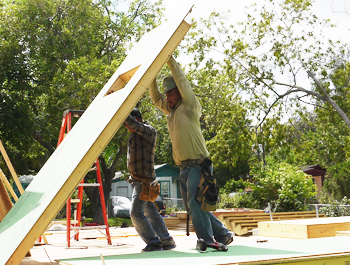Image

Nick Mitchell-Bennett, Executive Director, Community Development Corp. of Brownsville
Challenge: Disaster recovery has been a challenge in the Rio Grande Valley in Texas. Six years after Hurricane Dolly hit the valley in 2008, residents were still waiting for assistance, many of them among the poorest in the country. Their semi-rural subdivisions lacked potable water, sanitary sewage systems and adequate roads.
Texas hurricanes Rita in 2005, Ike in 2008 and Dolly in 2008 caused $2 billion in damage and exposed the inadequate disaster recovery response of local, county, state and federal agencies. Many of the victims are from "Colonias," semi-rural subdivisions lacking basic infrastructure, potable water, sanitary sewage systems and adequate roads. More than 40 percent of the 500,000 residents in these Colonias live below the poverty line, while an additional 20 percent live at or just above the poverty line. They could not afford to rebuild their destroyed or severely damaged homes themselves and had to rely on government aid.
The Community Development Corp. of Brownsville (CDCB) is an affordable housing nonprofit devoted to partnering with other organizations to create sustainable communities across the Rio Grande Valley through quality education, model financing, efficient home design and superior construction. We serve one of the poorest regions in the country, the Lower Rio Grande Valley, where one in three people live below the poverty line. Persistent poverty coupled with the threat of natural disasters creates the need for an efficient and affordable way to address disaster recovery.
Our organization created the Rapid Disaster Recovery Housing Program (RAPIDO) with our partners in response to inadequate government aid after hurricane Dolly. RAPIDO's plan addresses three of the biggest obstacles of the current disaster recovery model: slow transition from disaster response to housing recovery; the need for a designated resource for each family and the lack of pre-disaster planning.
Transition: The transition from disaster response to housing recovery is a lengthy process that can put vulnerable communities at risk. RAPIDO is a temporary-to-permanent solution, providing immediate housing as a first step toward a permanent home. CDCB and the design nonprofit, bcWorkshop, designed and built 21 prototype homes in the Rio Grande Valley to test a scalable solution. The goal is getting families into a home within four to six months rather than the six years it could take under the government system. We shrink the timeframe by providing a "CORE" on the resident's lot, a simple structure with essential living facilities that can easily be expanded once full recovery is underway. The CORE's pre-fab construction takes three days in a local lumber yard, prior to a disaster, and can be assembled on site by hand in four days.
 Disaster Recovery Design: Disaster recovery requires a focus on community outreach, case management, eligibility and policy. Low-income families affected by a natural disaster find it difficult to navigate the process of receiving assistance. RAPIDO is designed as a comprehensive system that empowers local teams to help families recover. Each family is assigned a "navigator" who acts as the primary contact through the entire recovery process, understands all aspects of the rehousing process and knows the steps required to receive assistance quickly and efficiently. A trained local eligibility team who determines if a family qualifies for assistance works closely with a family's navigator to ensure they are aware of the process and documents needed.
Disaster Recovery Design: Disaster recovery requires a focus on community outreach, case management, eligibility and policy. Low-income families affected by a natural disaster find it difficult to navigate the process of receiving assistance. RAPIDO is designed as a comprehensive system that empowers local teams to help families recover. Each family is assigned a "navigator" who acts as the primary contact through the entire recovery process, understands all aspects of the rehousing process and knows the steps required to receive assistance quickly and efficiently. A trained local eligibility team who determines if a family qualifies for assistance works closely with a family's navigator to ensure they are aware of the process and documents needed.Pre-disaster planning "Pre-covery": The RAPIDO model starts recovery activities prior to a disaster by creating a catalog of homes that residents can use when designing their new home once rebuilding begins. RAPIDO handles pre-procurement of permits from city and county agencies and trains contractors to construct, store and reconstruct CORE units. RAPIDO also trains organizations and individuals as navigators for families so everything is in place to support local jurisdictions and families through the recovery process.
CDCB, bcWorkshop and experts at the Texas Low Income Housing Information Service created a Rapid Disaster Recovery Housing Program technical guide and policy recommendations. This document outlines policy changes to make at the local, state and federal levels to respond to a disaster quickly and effectively. The Texas legislature's committee on Intergovernmental Relations is reviewing the recommendations needed to make RAPIDO the state's disaster recovery solution.
Maria Cordero was just one of the many clients who was glad to be involved in the process. "RAPIDO Design wasn't just a plan that they imposed on us that we just had to accept, they gave us the opportunity to choose details," she says.
We learned that planning and partnering with other organizations could reduce the impact of a disaster on low-income families. The RAPIDO model can be replicated in any location. Construction costs may differ but the process is the same: a state or city must partner with local organizations to create a housing catalog, pre-permit post-disaster building, pre-construct the CORE and store it for accessibility for reconstruction. The technical guide explains required training and can be used to recruit organizations that are close to the community to be navigators during the recovery process, ensuring that low-income disaster victims will have support.

